Scientific program
Official conference language will be English
Invited talks
Day 1 (September, 17th) morning
Karel Schulmann (Czech Geological Survey, Prague):
Relative contribution of tectonic inheritance and far field forces on the building of Paleozoic European crust
Day 1 (September, 17 th ) afternoon
Jürgen von Raumer (University of Fribourg):
Variscan basement in Europe: travelling through time and space
Day 2 (September, 18 th ) morning
Jan Golonka (Jagiellonian University in Krakow):
Phanerozoic paleogeography of Central Europe
Conference topics and Special Sessions
Topic 1: Building Central Europe: geodynamics of the Variscan lithosphere
Covers hard geology, structure and tectonics, regional geology, and geophysics
Special Session: Recent advances in unraveling Variscan orogeny in the Bohemian Massif
Conveners: K. Schulmann, F. Finger
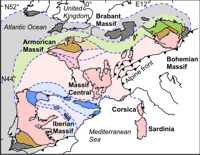 The Variscan orogeny in Europe resulted from amalgamation of continental blocks derived from Gondwana during its Ordovician fragmentation. This process was associated with major magmatic and tectono-metamorphic reworking of Proterozoic crust, the timing and intensity of which varied along the axis of the orogen. The Sassari Variscan meeting in 2012 showed that the Central–Western Variscan branch is dominated by Visean HP granulite facies event accompanied by specific perpotassic magmatism whereas the southern Variscan Europe exhibits major magmatic reworking from Late Carboniferous to Permian. The occurrences of Late Carboniferous HP granulites in Morocco Rif together with recently described metamorphic domes in the Morroco Messeta suggest a clear connection of northern Africa to southern European Variscan outcrops in Pyrenees, Sardinia, Southern France, and Italy. It is also increasingly evident that the Variscan system west of Bray fault zone is markedly different as compared to the Bohemian Massif, Schwarzwald, and Vosges Variscan outcrops. Therefore, Variscan Europe shows variations from West to East suggesting potential subduction zone flip between the French Massif Central and the Eastern Variscides as well as completely different mechanisms of crustal thickening. In addition, the contrast between southern and central Europe calls for complete re-evaluation of our perception of so far unified Variscan system. Therefore, the upcomming Pilsen meeting will be an opportunity to continue in promising trend of vibrant scientific progress in understanding the European Variscan belt.
The Variscan orogeny in Europe resulted from amalgamation of continental blocks derived from Gondwana during its Ordovician fragmentation. This process was associated with major magmatic and tectono-metamorphic reworking of Proterozoic crust, the timing and intensity of which varied along the axis of the orogen. The Sassari Variscan meeting in 2012 showed that the Central–Western Variscan branch is dominated by Visean HP granulite facies event accompanied by specific perpotassic magmatism whereas the southern Variscan Europe exhibits major magmatic reworking from Late Carboniferous to Permian. The occurrences of Late Carboniferous HP granulites in Morocco Rif together with recently described metamorphic domes in the Morroco Messeta suggest a clear connection of northern Africa to southern European Variscan outcrops in Pyrenees, Sardinia, Southern France, and Italy. It is also increasingly evident that the Variscan system west of Bray fault zone is markedly different as compared to the Bohemian Massif, Schwarzwald, and Vosges Variscan outcrops. Therefore, Variscan Europe shows variations from West to East suggesting potential subduction zone flip between the French Massif Central and the Eastern Variscides as well as completely different mechanisms of crustal thickening. In addition, the contrast between southern and central Europe calls for complete re-evaluation of our perception of so far unified Variscan system. Therefore, the upcomming Pilsen meeting will be an opportunity to continue in promising trend of vibrant scientific progress in understanding the European Variscan belt.
Topic 2 Composing Central Europe: mantle and crustal evolution through time
Covers mineralogy, petrology, geochemistry, and geochronology
Special Session: Late Paleozoic volcanism in the Bohemian Massif
Conveners: C. Breitkreuz, V. Rapprich
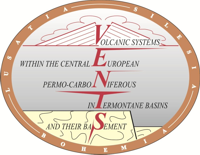 During the Late Carboniferous – Early Permian, the Bohemian Massif and in particular its northern margin was characterized by the formation of tectonically controlled, continental, intermontane basins and by strong volcanic activity. Volcanic and subvolcanic products of this post-orogenic, predominantly silica-rich, calc-alkaline magmatism are intercalated within the sedimentary fill of the intermontane basins. In addition, plutonic to subvolcanic igneous bodies cropping out in uplifted crystalline basement blocks adjacent to the basins, provide insights into the deeper levels of the Permo-Carboniferous magmatic and volcanic systems of the area. These systems reveal insight into the dynamic, magmagenetic and stratigraphic evolution during the Late Paleozoic in Central Europe, and, at the same time, studying these formations contributes to volcanosedimentary facies models in general. The Czech-German-Polish research group VENTS , active in this field since 2006, welcomes contributions to the topic described above!
During the Late Carboniferous – Early Permian, the Bohemian Massif and in particular its northern margin was characterized by the formation of tectonically controlled, continental, intermontane basins and by strong volcanic activity. Volcanic and subvolcanic products of this post-orogenic, predominantly silica-rich, calc-alkaline magmatism are intercalated within the sedimentary fill of the intermontane basins. In addition, plutonic to subvolcanic igneous bodies cropping out in uplifted crystalline basement blocks adjacent to the basins, provide insights into the deeper levels of the Permo-Carboniferous magmatic and volcanic systems of the area. These systems reveal insight into the dynamic, magmagenetic and stratigraphic evolution during the Late Paleozoic in Central Europe, and, at the same time, studying these formations contributes to volcanosedimentary facies models in general. The Czech-German-Polish research group VENTS , active in this field since 2006, welcomes contributions to the topic described above!
Special Session: Sedimentary provenance and evolution of the continental crust: Precambrian to present
Conveners: A. Gerdes, W. Dörr, U. Linnemann
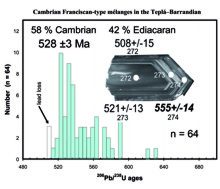 Sedimentary provenance analysis is used to identify source areas of clastic sediments in the past and present and helps to reconstruct facies models, regional uplift and erosion. Various methods and approaches are applied, among them the U–Pb analysis of detrital minerals such as zircon, rutile, and apatite. In case of detrital zircon, the U–Pb age pattern and their changes through time help to understand paleo-source reconstructions and to test the current paleogeographic models. Combined with the Hf isotope analyses of zircon it allows unique insights into the recycling and formation of new continental crust through the Earth’s history. We invite contributions to this special session that cover all aspects of the broad field of the sedimentary provenance analysis.
Sedimentary provenance analysis is used to identify source areas of clastic sediments in the past and present and helps to reconstruct facies models, regional uplift and erosion. Various methods and approaches are applied, among them the U–Pb analysis of detrital minerals such as zircon, rutile, and apatite. In case of detrital zircon, the U–Pb age pattern and their changes through time help to understand paleo-source reconstructions and to test the current paleogeographic models. Combined with the Hf isotope analyses of zircon it allows unique insights into the recycling and formation of new continental crust through the Earth’s history. We invite contributions to this special session that cover all aspects of the broad field of the sedimentary provenance analysis.
Topic 3 Sedimentary basins of Central Europe: a geologic archive from Precambrian to Cenozoic
Covers sedimentology, stratigraphy, and paleontology
Special Session: Sedimentary archives: from the past sea-level and climate change to human activity
Conveners: O. Bábek, T. Matys Grygar
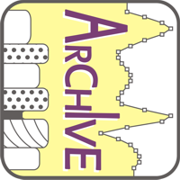 Learning lessons from the past, which lies in the heart of the science of sedimentology and stratigraphy, remains the key issue in predicting the future of mankind. The session´s focus will be given on analysis of stratigraphic record with clear interpretative aims such as past climates, sea-level changes, oceanographic overturns, tectonic, volcanic and extraterrestrial events as well as anthropogenic impact in the late Holocene. Authors are invited to present contributions utilizing a broad range of methods of sedimentary archive analysis covering various spatiotemporal frameworks from the deep past to the Recent and from basin-wide studies to high-resolution, mm-scale record. The main focus will be given to the state-of-the art stratigraphic methods based on a geochemical, geophysical and petrophysical proxies.
Learning lessons from the past, which lies in the heart of the science of sedimentology and stratigraphy, remains the key issue in predicting the future of mankind. The session´s focus will be given on analysis of stratigraphic record with clear interpretative aims such as past climates, sea-level changes, oceanographic overturns, tectonic, volcanic and extraterrestrial events as well as anthropogenic impact in the late Holocene. Authors are invited to present contributions utilizing a broad range of methods of sedimentary archive analysis covering various spatiotemporal frameworks from the deep past to the Recent and from basin-wide studies to high-resolution, mm-scale record. The main focus will be given to the state-of-the art stratigraphic methods based on a geochemical, geophysical and petrophysical proxies.
Special Session: Cretaceous basins of Central Europe: deciphering effects of global and regional processes
Conveners: D. Uličný, M. Wilmsen, T. Voight, M. Košťák
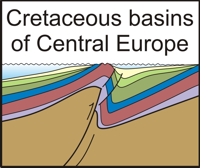 Cretaceous basins in Central Europe have recorded a number of global processes such as the long-term maximum in global sea level, peak greenhouse climate, as well as more recently recognized rapid climatic and sea-level changes. At the same time, regional tectonic signals interfered with the globally driven processes on various time scales. Widespread inversion of Cretaceous basins has become the hallmark of post-Variscan intra-plate tectonism in Central Europe. Considerable recent advances in integrated stratigraphic dating and high-resolution correlation now allow for major improvements in understanding of the stratigraphic records in different parts of Central Europe. The scope of this session is to bring together international specialists studying the Cretaceous period using different approaches such as facies analysis, sequence stratigraphy, petrology, structural geology, geochemistry, and palaeontology, in order to get a comprehensive picture of the role that Central Europe played in the Cretaceous world.
Cretaceous basins in Central Europe have recorded a number of global processes such as the long-term maximum in global sea level, peak greenhouse climate, as well as more recently recognized rapid climatic and sea-level changes. At the same time, regional tectonic signals interfered with the globally driven processes on various time scales. Widespread inversion of Cretaceous basins has become the hallmark of post-Variscan intra-plate tectonism in Central Europe. Considerable recent advances in integrated stratigraphic dating and high-resolution correlation now allow for major improvements in understanding of the stratigraphic records in different parts of Central Europe. The scope of this session is to bring together international specialists studying the Cretaceous period using different approaches such as facies analysis, sequence stratigraphy, petrology, structural geology, geochemistry, and palaeontology, in order to get a comprehensive picture of the role that Central Europe played in the Cretaceous world.
Topic 4 Shaping Central Europe: surface processes from past to present
Covers Quaternary geology and geomorphology
Topic 5 Earth systems management in Central Europe: geosciences and the environment
Covers applied geosciences including global change, hydrogeology, engineering geology, remote sensing, and environmental geochemistry
Special Session: GIS and 3D/4D modeling in Geosciences
Conveners: R. Lehné, H. Schaeben
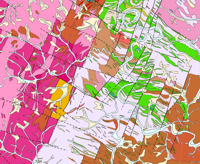 The importance of Geo Information Systems (GIS) and 3/4D-modelling in geosciences is increasing permanently. Here beside the application of available tools the development of task specific routines is often needed. This session is addressed to all people who use GIS, 3/4D-modelling or programming as a methodological approach in order to work on geoscientific tasks. The session thus calls for contributions which are related either to the development of methodological approaches or to results derived from application of GIS, 3/4D-modelling or programming.
The importance of Geo Information Systems (GIS) and 3/4D-modelling in geosciences is increasing permanently. Here beside the application of available tools the development of task specific routines is often needed. This session is addressed to all people who use GIS, 3/4D-modelling or programming as a methodological approach in order to work on geoscientific tasks. The session thus calls for contributions which are related either to the development of methodological approaches or to results derived from application of GIS, 3/4D-modelling or programming.
Special Session: Urban geology
Conveners: R. Lehné, K. Royse, A. Hoppe
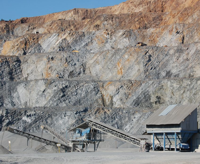 Today, the large global population stretches the resilience of the environment to a possible maximum. This is especially true in urban areas, where the majority of the global population is living today. The metabolism of cities, its growing needs for clean water and raw material for constructions while simultaneously egesting waste into its neighbourhood, require a thorough understanding of its undergrounds and peripheries as well as safe construction sites. This special session is open to contributions in urban geology and especially those utilizing computer based Geo Information Systems and 3 to 4D-techniques to qualify and to quantify resources and hazards in the peripheries of urban areas. The aggregation of complex geological and spatial data to thematic maps enables a better understanding and interpretation by local decision makers.
Today, the large global population stretches the resilience of the environment to a possible maximum. This is especially true in urban areas, where the majority of the global population is living today. The metabolism of cities, its growing needs for clean water and raw material for constructions while simultaneously egesting waste into its neighbourhood, require a thorough understanding of its undergrounds and peripheries as well as safe construction sites. This special session is open to contributions in urban geology and especially those utilizing computer based Geo Information Systems and 3 to 4D-techniques to qualify and to quantify resources and hazards in the peripheries of urban areas. The aggregation of complex geological and spatial data to thematic maps enables a better understanding and interpretation by local decision makers.
email: jirizak(at)natur.cuni.cz, g.zulauf(at)em.uni-frankfurt.de
Webhosting provided by 1&1 Internet AG.